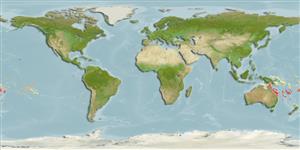>
Ovalentaria/misc (Various families in series Ovalentaria) >
Plesiopidae (Roundheads) > Plesiopinae
Etymology: Plesiops: Greek, plesios = near + Greek, ops = appearance (Ref. 45335); insularis: From the the Latin word meaning 'of islands', referring to the present distribution of the species , in the islands of the New Caledonia Basin region.
More on authors: Mooi & Randall.
Environment: milieu / climate zone / depth range / distribution range
Écologie
marin récifal; profondeur 0 - 25 m (Ref. 27772), usually 2 - 25 m (Ref. 27772). Temperate
Southwest Pacific: islands in the Coral and Tasman seas, including Lord Howe Island and the nearby Elizabeth and Middleton reefs, Norfolk Island, New Caledonia, and Chesterfield Bank. Western Central Pacific (Ref. 12926). Recently reported from Tonga (Ref. 53797).
Taille / Poids / Âge
Maturity: Lm ? range ? - ? cm
Max length : 9.8 cm SL mâle / non sexé; (Ref. 27772)
Adults inhabit coral reef (Ref. 75154) and tide pools (Ref. 27772). Benthic (Ref. 75154). Eggs are guarded by the male parent (Ref. 205).
Life cycle and mating behavior
Maturité | Reproduction | Frai | Œufs | Fécondité | Larves
Eggs are guarded by the male parent (Ref. 205).
Mooi, R.D., 1995. Revision, phylogeny, and discussion of biology and biogeography of the fish genus Plesiops (Perciformes: Plesiopsidae). Life Sci. Contrib. No. 159, 108 p. (Ref. 27772)
Statut dans la liste rouge de l'IUCN (Ref. 130435: Version 2024-2)
Menace pour l'homme
Harmless
Utilisations par l'homme
Outils
Articles particuliers
Télécharger en XML
Sources Internet
Estimates based on models
Preferred temperature (Ref.
123201): 24.4 - 27.3, mean 26.1 °C (based on 94 cells).
Phylogenetic diversity index (Ref.
82804): PD
50 = 0.5000 [Uniqueness, from 0.5 = low to 2.0 = high].
Bayesian length-weight: a=0.01202 (0.00501 - 0.02886), b=2.98 (2.77 - 3.19), in cm total length, based on LWR estimates for this (Sub)family-body shape (Ref.
93245).
Niveau trophique (Ref.
69278): 3.5 ±0.5 se; based on size and trophs of closest relatives
Résilience (Ref.
120179): Haut, temps minimum de doublement de population inférieur à 15 mois (Preliminary K or Fecundity.).
Fishing Vulnerability (Ref.
59153): Low vulnerability (10 of 100).
Nutrients (Ref.
124155): Calcium = 37.8 [14.8, 72.2] mg/100g; Iron = 0.269 [0.144, 0.487] mg/100g; Protein = 19.2 [18.1, 20.3] %; Omega3 = 0.427 [0.215, 0.862] g/100g; Selenium = 4.43 [1.88, 10.37] μg/100g; VitaminA = 120 [30, 489] μg/100g; Zinc = 0.876 [0.547, 1.371] mg/100g (wet weight);
